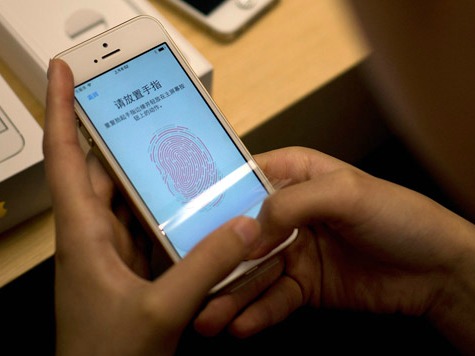
The fingerprint sensor on the new iPhone 5S, which was released on Friday to much fanfare, is causing privacy concerns among lawmakers in light of revelations that the National Security Agency has collected information from nearly all of the country’s major technology companies.
Sen. Al Franken (D-MN) wrote Apple CEO Tim Cook a letter about his concerns about the sensor, which allows users to unlock their phones with their fingerprints instead of a four-digit passcode. Users can also disable the feature if they do not feel comfortable with it.
In his letter, Franken wrote that the fingerprint sensor “raises substantial privacy questions for Apple and for anyone who may use your products,” and he wanted to “establish a public record of how Apple has addressed these issues internally and in its rollout of this technology to millions of my constituents and other Americans.”
“Let me put it this way: if hackers get a hold of your thumbprint, they could use it to identify and impersonate you for the rest of your life,” Franken wrote.
Apple has claimed “the fingerprint data is stored on the phone in a place that’s inaccessible to other apps and to Apple’s remote servers.” In addition, “Apple also has put in a number of safeguards, including requiring a passcode after a restart and 48 hours of inactivity.” Apple has also claimed the sensor reads “a sub-epidermal layer of the finger” and so people cannot use an “existing fingerprint and convert it into something the phone will recognize.”
Franken, though, pointed out that while “passwords are secret and dynamic; fingerprints are public and permanent.”
“If you don’t tell anyone your password, no one will know what it is. If someone hacks your password, you can change it–as many times as you want. You can’t change your fingerprints. You have only ten of them,” he wrote. “And you leave them on everything you touch; they are definitely not a secret. What’s more, a password doesn’t uniquely identify its owner–a fingerprint does.”
Franken asked that Apple in his letter to provide answers to these questions:
(1) Is it possible to convert locally-stored fingerprint data into a digital or visual format that can be used by third parties?
(2) Is it possible to extract and obtain fingerprint data from an iPhone? If so, can this be done remotely, or with physical access to the device?
(3) In 2011, security researchers discovered that iPhones were saving an unencrypted file containing detailed historical location information on the computers used to back up the device. Will fingerprint data be backed up to a user’s computer?
(4) Does the iPhone 5S transmit any diagnostic information about the Touch ID system to Apple or any other party? If so, what information is transmitted?
(5) How exactly do iTunes, iBooks and the App Store interact with Touch ID? What information is collected by those apps from the Touch ID system, and what information is collected by Apple associated with those interactions, including identifiers or hashes related to the fingerprint data?
(6) Does Apple have any plans to allow any third party applications access to the Touch ID system or its fingerprint data?
(7) Can Apple assure its users that it will never share their fingerprint data, along with tools or other information necessary to extract or manipulate the iPhone fingerprint data, with any commercial third party?
(8) Can Apple assure its users that it will never share their fingerprint files, along with tools or other information necessary to extract or manipulate the iPhone fingerprint data, with any government, absent appropriate legal authority and process?
(9) Under American privacy law, law enforcement agencies cannot compel companies to disclose the “contents” of communications without a warrant, and companies cannot share that information with third parties without customer consent. However, the “record[s] or other information pertaining to a subscriber… or customer” can be freely disclosed to any third party without customer consent, and can be disclosed to law enforcement upon issuance of a non-probable cause court order. Moreover, a “subscriber number or identity” can be disclosed to the government with a simple subpoena. See generally 18 U.S.C. § 2702-2703
Does Apple consider fingerprint data to be the “contents” of communications, customer or subscriber records, or a “subscriber number or identity” as defined in the Stored Communications Act?
(10) Under American intelligence law, the Federal Bureau of Investigation can seek an order requiring the production of “any tangible thing (including books, records, papers, documents, and other items)” if they are deemed relevant to certain foreign intelligence investigations. See 50 U.S.C. § 1861.
Does Apple consider fingerprint data to be “tangible things” as defined in the USA PATRIOT Act?
(11) Under American intelligence law, the Federal Bureau of Investigation can unilaterally issue a National Security Letter that compels telecommunications providers to disclose “subscriber information” or “electronic communication transactional records in its custody or possession.” National Security Letters typically contain a gag order, meaning that recipients cannot disclose that they received the letter. See, e.g., 18 U.S.C. § 2709.
Does Apple consider fingerprint data to be “subscriber information” or “electronic communication transactional records” as defined in the Stored Communications Act?
(12) Does Apple believe that users have a reasonable expectation of privacy in fingerprint data they provide to Touch ID?

COMMENTS
Please let us know if you're having issues with commenting.